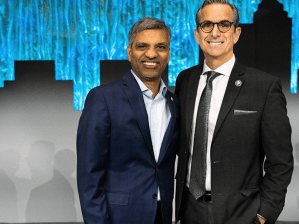Getting to Zero: New Pathways to Green Building
The former leader of the U.S. Green Building Council on his plan to promote net-zero emissions.

Mahesh Ramanujam believes adopting green building practices is no longer enough. Image courtesy of Global Network for Zero
After nearly a decade of working at the U.S. Green Building Council, Mahesh Ramanujam—in partnership with Sarah Merricks and Scot Horst—founded the Global Network for Zero with the goal to accelerate ESG compliance and recreate the world into one with zero emissions. The vision behind the organization stems from years of experience and discussions with CRE leaders, as well as laborious market research.
In only a year since its debut, GNFZ has launched a net-zero certification for existing buildings, with a second one coming later this year. The certification currently in use calculates clients’ Scope 1, 2 and 3 emissions, and then guides them through the process of setting targets, developing plans and implementing strategies to get to net-zero. About this and more, in the interview below.
Which accomplishments in your effort toward net-zero commitments are you most proud of?
Ramanujam: Prior to co-founding GNFZ, I played a key role in ensuring LEED became the world’s premier green building program. Together with my team and the support of our community, we dramatically expanded LEED’s reach, covering 182 countries and territories, with one-third of projects coming from outside the U.S., transformed LEED beyond just buildings to cities and communities, and future-proofed the rating system to better integrate public health, equity, resilience and decarbonization requirements.
As President & CEO of USGBC and GBCI, I spoke often of the pride I took in moving individuals, companies and communities from an awareness of green building practices, to an adoption of them. Today, what I’m most proud of is that GNFZ is building on that promise. Adoption is no longer enough. Acceleration—scaling our efforts and doing so in advance of even the Paris Agreement’s 2030 targets is what we’re laser-focused on with our partners. I’m beyond proud that with the launch of GNFZ’s net-zero certification for existing buildings, we are helping scale progress in a sector that has traditionally faced roadblocks in achieving sustainability.
Our partnership with Shree Ramkrishna Exports, one of the world’s leading diamond crafting companies, highlights how GNFZ is already delivering on our promise of acceleration. Previously, SRK committed to achieving net-zero at their two flagship facilities by 2030. By using our platform, SRK is on track to certify both existing buildings by 2024. When I see all this coming together and that we have not just a proof of concept, but a proof of product, platform and partnership, I’m not just proud, I’m hopeful about the future.
Which sectors and areas/countries are making significant progress toward reaching net-zero emissions by 2050?
Ramanujam: The U.S. electric power sector comes to mind as it has made tremendous progress toward net-zero operations. There’s plenty of evidence to suggest that the Biden-Harris administration’s carbon-free electricity by 2035 goal is within reach, as long as challenges such as transmission capacity constraints and distribution transformer shortages are addressed. By comparison, transportation sector emissions have grown to eclipse the power sector as the country’s most polluting sector, and building emissions have remained stubbornly high.
I have to say though, that referring to 2050—in any discussion about net-zero—is going to be a moving target, as in that will not hold. That’s not going to cut it for companies and countries across the board. And we know that, if for no other reason, based on the warming intensification we’ve seen thus far in 2023.
Regarding countries and regions, the U.S. gets an honorable mention. The U.S. Inflation Reduction Act and the Infrastructure Investment and Jobs Act are monumental pieces of climate change mitigation and adaptation legislation. And there’s promising progress across a number of states and municipalities. Statutory and regulatory policies designed to eliminate fossil fuels from our energy system, advance energy efficiency and adapt our infrastructure and communities to the challenges of a changing climate are all welcome, regardless of their reach.
READ ALSO: Building Performance Policies Across the US
But if I had to pick one jurisdiction, it would be the European Union. Their sustainable finance agenda—including the Taxonomy Regulation, the Corporate Sustainability Reporting Directive, the Sustainable Finance Disclosure Regulation and the newer Corporate Sustainability Due Diligence Directive—is an especially welcome addition to the global climate action arsenal, although some kinks need to be worked out. I also admire Brussels making a priority of the buildings sector, including through the updates a few years ago to the Energy Performance of Buildings Directive and the Energy Efficiency Directive, both of which are meant to serve the ‘renovation wave’ strategy that the bloc’s policymakers are pursuing.
Which are the least promising sectors/areas and why is that?
Ramanujam: I would not necessarily say that any sector, area or country is the least promising. I think many people are trying to put their best foot forward. Obviously, we need to divest from our global fossil fuel economy and put that money into new, more sustainable modes of energy production and consumption. Of course, the global buildings and construction sector which, according to the UN Environment Programme emitted more in 2021 than any year before, is also behind. This is precisely why the Global Network for Zero is starting with a focus on the existing buildings sector.
Roughly 98 percent of buildings around the world are existing. There are 100 million buildings in the U.S. alone. Retrofitting these buildings globally and at scale would help us drastically reduce our emissions and get us close to Paris Agreement targets. But despite decades of green building efforts, we still have not reduced the building sector’s contribution to emissions.
The number one barrier here isn’t technology, it’s ROI data. My organization did research in the first quarter of 2022, conducting in-depth interviews with policy elites and industry leaders in the U.S., followed by a general population survey. And what we heard most is that ROI data was needed to advance net-zero in buildings.
Data and education are critical solutions. Good data on ROI and transparency will help us convince stakeholders and investors, and enable the decarbonization of existing buildings to scale. And using that data to educate building owners, developers, their investors, tenants and others about the benefits of building energy efficiency retrofits will add still more momentum.
With progress toward net-zero quite spotty across the map and sectors, how can governments, businesses and communities foster a collaborative approach?
Ramanujam: Businesses and households need incentives to invest in net-zero, as well as government-backed, enforceable measures to ensure that those incentives are leveraged to the fullest extent. But we can’t discount the importance of information. This ties back into the need for transparency and standardization with corporate climate risks and transition planning.
Similarly, we need credible information describing both climate risks and the slate of technological and financial resources available to address them. One development we’ve been pleased with is the range of physical climate risk analysis tools that the Biden-Harris administration has made available. Similarly, we’ve admired the communications and outreach efforts undertaken by the White House, as well as professional services firms, climate advocacy and environmental justice groups, to keep the IRA’s intended funding recipients informed of the opportunities available to them.
READ ALSO: How New Energy Goals Impact Boston’s Buildings
And we need corporates, nonprofits and academic institutions to continue beating the drum. For companies, my GNFZ colleagues and I see real value in going beyond the issuance of assured climate risk disclosures and transition plans. We need to know what’s worked for these companies and what hasn’t. We trust that technologists, financiers, management consultants and other solutions providers will be more inclined to invest in the R&D and commercialization of net-zero-enabling technologies if they have a determinate market to serve.
And for nonprofits and academic institutions, it’s important they fill the gaps in our knowledge with objective, empirical evidence. We need to know what works and what doesn’t. Just look at the value-add that Princeton ZERO Lab and Energy Innovation Policy & Technology’s Energy Policy Simulator, for instance, have brought to the policymaking pipeline, and what Columbia University and the Environmental Defense Fund have done to make engagement with the IRA implementation process more accessible.
What solutions are there to unify progress toward net-zero, and how open are the world leaders to offer and to receive said solutions/help?

Mahesh Ramanujam and Pearl Homes Managing Partner Marshall Gobuty. Pearl Homes uses GNFZ for its buildings. Image courtesy of Global Network for Zero
Ramanujam: One of the things that would most help unify progress would be dramatically improved collaboration and cooperation between the various certification entities—this would be particularly useful in eliminating the inertia among building developers, owners and managers. Outgoing Urban Land Institute Global Chair Peter Ballon’s argument that the real estate industry should collaborate rather than compete in decarbonization efforts and be more proactive with knowledge sharing, especially with investors, is particularly resonant.
Information about the climate risks that companies face, as well as the strategies and tactics they’ve employed to address them, will also be crucial and, evidently, universally appealing. While the U.S. Securities and Exchange Commission has yet to finalize, adopt and implement its proposed corporate climate risk disclosure rule, we have regulators in the UK, EU and other jurisdictions blazing a path forward. The International Organization of Securities Commissions is now endorsing the work of the non-governmental International Sustainability Standards Board’s ‘global baseline’ for corporate climate and sustainability disclosures. We can expect to see uniform progress toward globally consistent disclosure standards soon, which will give corporates and investors the information they need to march forward.
READ ALSO: Greening an Entire City: The Ithaca Model
In the meantime, one of the things we’re trying to achieve at GNFZ is to demonstrate that net-zero achievement, for lack of a better word, isn’t ‘scary.’ It’s within reach. It doesn’t have to be expensive. It shouldn’t be a political football. And it has countless access points to ensure no building, person, company, or community gets left behind. What matters is that corporations take a strategic, incremental approach to cost deployment and net-zero project delivery on the path to net-zero operations.
Otherwise, GNFZ sees real benefits in incremental acceleration, as in, strategically planning cost deployment and project delivery to optimize the accrual rate of both operational emissions reductions and energy cost savings. But this can only be achieved at scale if net-zero implementers have the necessary information. This notion of incrementalism applies to governments, too. Building emissions and energy efficiency regulations, for instance, ought to come with incremental compliance timelines, incentives for going beyond the minimum requirements, and other supplements.
Put simply, we need mechanisms to level the playing field both for governments and their corporates and citizens. Otherwise, this fear of a first-mover disadvantage for climate action will remain in place.
How can countries balance economic growth with the imperative need to reduce emissions and achieve net-zero by 2050?
Ramanujam: The most straightforward answer is that the energy transition is an economic transition. Transforming our fossil fuel-dependent energy system will generate countless jobs at home and abroad. Investments in the wake of the IRA are already earning under-industrialized regions of the U.S. nicknames like ‘the Battery Belt.’
Of greater concern is how governments deliver a fair, equitable and sustainable energy and economic transition.
Unfortunately, there are some caveats with that outlook. One of the principal grievances aired by leaders of developing countries is that rich, industrialized countries are denying them the right to pursue the same development pathway as they did. Equity comes into play here. It’s about assuming responsibility. The U.S., UK, EU, China, Japan and other infrastructurally modern nations must step up and ensure that their less well-off neighbors have the financial and technical support needed to successfully deviate from a fossil fuel-dependent economic development pathway.
Building codes and standards play a major role in the sustainability of infrastructure and buildings. How can countries update and enforce regulations to sustain the net-zero by 2050 goal?
Ramanujam: From China to the EU, from the UK to the U.S., many countries are already working to update their building energy performance standards and building energy codes to help reach the 2050 goal. Each has its own merits and drawbacks.
In our view, what’s most effective are policies that enable building developers, owners, managers and yes, investors, to take an incremental approach to meeting a discrete minimum threshold. And beyond setting rules and enforcing compliance, governments will need to facilitate regulatory compliance and motivate firms to go beyond the required minimum.
Regarding motivation, the breadth and depth of incentives made available for building performance-enhancing initiatives cannot be limited to what’s needed for regulated businesses to achieve compliance. Instead, there should be incentives for technologies and services that promise not only regulatorily compliant energy efficiency, but net-zero operations. And quite frankly, at some point, these incentives are going to have to include concrete language and follow-through around dates well in advance of 2050.








You must be logged in to post a comment.